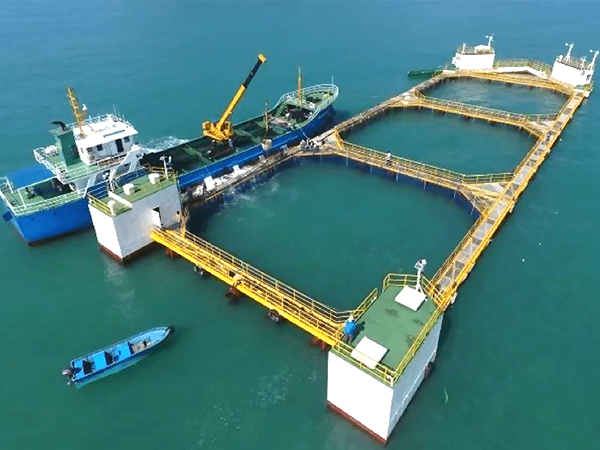How much do you know about deep water net cage fish farming?
Seawater aquaculture cages are generally deep-water windproof cages, which refer to large cages set in the deep sea with a water depth of 6-15 meters or more and a breeding capacity of over 1500 cubic meters. Deep water windbreak cages have strong wind, wave, and current resistance capabilities, and are generally composed of four parts: frame, mesh, anchorage, and accessories.
In order to fully utilize the aquaculture area and maintain its ecological environment conditions, prevent eutrophication caused by pollution in the aquaculture area, and lead to the spread of fish diseases, the area of net cages should not exceed 10% of the aquaculture area. The layout of net cages should be suitable for water flow and ensure smooth water flow. For the convenience of business management, two groups can be arranged side by side, with a distance of 80-100 centimeters between groups, and a management channel can be set in the middle; The distance between the columns should be more than 50 meters, and the cage should be more than 200 meters from the coast.

What is the structural form of deep water anti wind and wave cage aquaculture in China?
Deep water cages are mainly divided into gravity type wind resistant cages, lifting cages, large fences, bottom mounted cages, and deep-sea aquaculture platforms in terms of structural form. They can also be divided into square, circular, spherical, butterfly, and ship types.
Among them, the lifting type wind and wave cage can be adjusted in depth according to needs, as it can be arranged in deeper waters, so it is also called a lifting type deep water wind and wave cage. Compared with traditional cages, large deep-water cages have advantages such as strong wind and wave resistance, large breeding capacity, fast fish growth, and good product quality. The most important thing is to quickly fill the main buoyancy tube with water before the arrival of a typhoon or red tide, so that the cage can sink to a depth of 7-8 meters underwater, enabling it to withstand more than 12 typhoons, with a wave resistance of up to 5 meters and a current resistance of up to 1 meter. After a disaster occurs, the main buoyancy tube inside the cage will be inflated, so that fish will not escape or die due to the disaster, and farmers will also reduce unnecessary losses.

In the use of deep water cages for raising fish in the deep sea, the following three parts of operations should be done well: suitable deep water cages, good supporting aquaculture facilities, and exquisite aquaculture techniques.
At present, China mainly has three types of domestically produced deep water cages: high-density polyethylene (HDPE) circular deep water cages, wind and wave resistant metal cages, and steel platform cages. HDPE circular deep water net cage is currently the most commonly used type of deep water net cage in domestic aquaculture, with more than 10000.
So far, China has developed deep-water net cages with a circumference of 40-160m, aquaculture water bodies of 700-20000 cubic meters, and a single net cage production capacity of 600 tons. The aquaculture water bodies and production capacity are tens to hundreds of times that of traditional small offshore net cages.
In addition, the successful assembly of the cage and monitoring platform greatly facilitates the feeding and observation of fish fry by cage breeders. Mobile real-time monitoring cage technology allows staff to observe the status of fish fry anytime and anywhere, greatly improving the reproductive efficiency of staff.
Haosail Machinery’s high clear copper alloy cage net has five major advantages in deep-sea cage aquaculture:
1. Wear resistance and seawater corrosion resistance;
2. Preventing biological attachment: Excellent permeability can improve the water quality environment for fish growth, effectively reduce pest and disease losses, and also reduce the maintenance cost of regular cleaning of nets;
3. High tensile strength: The tensile strength of the single wire of the net clothing reaches 1373Mpa, which is 150% of the pure copper net clothing single wire strength, increasing the effective breeding volume (over 20%) and reducing the risk of fish escaping;
4. The service life exceeds 5 years;
5. Low comprehensive cost: It is one-third of the comprehensive cost of the same volume nylon mesh and ultra-high molecular weight nets.

The intelligent control platform for net cages will promote the transformation of fishery aquaculture from offshore to intelligent, from net cages to large-scale equipment, and from traditional manual to automated and intelligent, providing great help for China’s seawater aquaculture and fishery resource utilization. At the same time, it has also created a good beginning for Chinese enterprises to fully enter the emerging industry of intelligent seawater cage aquaculture.
Net cage fish farming is a new technology in China that has been adjusting its fishing structure in recent years, reducing the pressure on the fishing environment in port areas, and accelerating the construction process of the fishing industry. Net cage fish farming is a new technology that has the characteristics of high yield, low cost, small investment, convenient management, land saving, water saving, and energy conservation, and has developed intensively in the world in recent years. At present, it has been promoted to various major water bodies in China and is a new type of fish farming with broad prospects.
